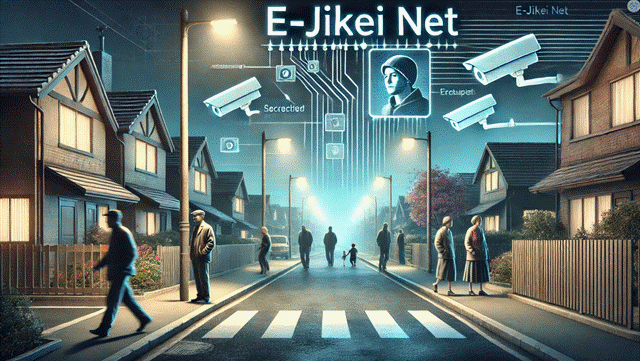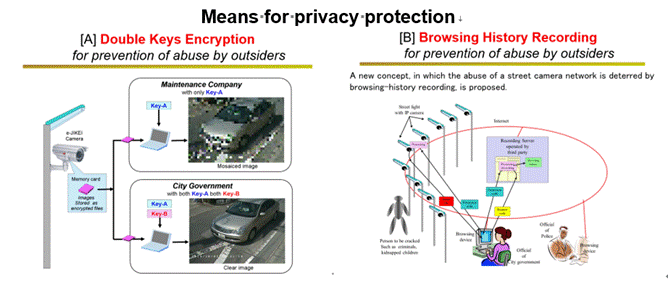
[Topic-4] e自警ネットワーク / e-JIKEI Network
昔の地域社会に存在した相互見守り,自警を,電子情報通信技術の助けを借りて,現代に再現したいという思いから,「e自警ネットワーク」という名前を付けました.私たちは,日本を次のようにしたいと考えています.
* 防犯カメラ(見守りカメラ)で,死角なく見守られた日本の実現.
* 但し,一般市民のプライバシーは厳重に保護される日本の実現.
* そして,日本発の安全・安心な地域社会の実現法を,世界中の地域社会に広げたい!
「e自警ネットワーク」の普及より,子どもが誘拐されることのない社会,ただし,一般市民のプライバシーは厳格に保護される社会の実現を願っています.
The name “The e-JIKEI Network” was inspired by
the desire to recreate, in the modern era, the mutual watchfulness and
self-monitoring that existed in traditional local communities, with the
assistance of electronic information and communication technologies. Our vision
for Japan is as follows:
* To achieve a Japan where surveillance cameras (monitoring cameras) provide
comprehensive coverage without blind spots.
* To ensure that the privacy of ordinary citizens is rigorously protected.
* To spread Japan's safe and secure community model to local communities around
the world!
Through the promotion of the e-JIKEI
Network, we aspire to create a society where children are never abducted
and the privacy of ordinary citizens is strictly safeguarded.
NPOe自警ネットワーク研究会は,2002年に任意団体として設立され,2009年にNPO法人化されました.2004年に自宅前見守り用ソフトの無料ダウンロードサービス開始以来,これまで,新聞・TVで約200回,紹介されています.
The NPO
e-JIKEI Network Promotion Institute was established as a voluntary organization
in 2002 and became an NPO in 2009. Since the launch of the free download
service for home-front monitoring software in 2004, the organization has been
featured approximately 200 times in newspapers and on TV.
2016年に発表した論文「5」では,全ての街路灯にネットワークカメラを内蔵させることの実現可能性について,論じています.街路灯にネットワークカメラを組み込むことで,犯罪防止や行方不明者の発見など社会安全性が向上すると同時に,低コストでの実現が可能です.一方で,プライバシー侵害や監視社会化への懸念が課題であり,悪用防止のためのアクセス制御や閲覧履歴の記録など,技術的・社会的な対策が必要です.この仕組みが信頼されることで,新たな社会インフラとして受け入れられる可能性があります.
In the
paper [5], published in 2016, we discussed the feasibility of integrating
network cameras into all streetlights. By embedding network cameras into
streetlights, we can enhance social safety through crime prevention and the
discovery of missing persons while achieving implementation at a low cost.
However, challenges such as privacy violations and concerns about a
surveillance society arise. To prevent misuse, technical and social measures
are necessary, including access controls and maintaining complete records of
browsing history. By building trust in this system, it has the potential to be
accepted as a new form of social infrastructure.
[5] Yusaku Fujii and Noriaki Yoshiura, “Will
every streetlight have network cameras in the near future?”, SCIENCE, eLetter (21 October 2016).
http://science.sciencemag.org/content/347/6221/504/tab-e-letters
上記の論文[5]では,以下のような議論を展開しています.
In the aforementioned paper [5], the following
discussions are presented:

1.
街路灯とネットワークカメラの統合の可能性
Integration
of Streetlights and Network Cameras
- LED街路灯と低コストのスマートフォンを組み合わせることで,低コストで実現可能.
- IoTの普及により,インターネット接続のコストがさらに低下する見込み.
- 街路灯の定期的な交換時に導入することで,「街路カメラ」としての設置コストはほぼ無視できる.
- Combining LED
streetlights with low-cost smartphones makes implementation highly
cost-effective.
- The widespread
adoption of IoT is expected to further reduce the cost of internet
connectivity.
- Introducing this
system during the regular replacement of streetlights renders the installation
cost for "street cameras" almost negligible.
2.
社会安全性への貢献 / Contribution to Social
Safety
- 犯罪者の追跡や行方不明者の発見など,問題解決効果に加えて,犯罪抑止効果が期待される.
- カメラ密度が十分に高ければ,低品質なカメラでも確実な追跡が可能.
- 人物や車両の自動追跡,異常行動の自動検知などの技術がこのインフラに活用される可能性がある.
- 必要に応じた照明強度の調整による街路灯の消費電力節約も実現可能.
·
Beyond solving issues such as tracking criminals
and finding missing persons, the system is expected to have a crime deterrent
effect.
·
With a sufficiently high camera density, even
low-quality cameras can enable reliable tracking.
·
Technologies such as automatic tracking of
individuals and vehicles, as well as automatic detection of abnormal behavior,
could be applied to this infrastructure.
·
Adjusting the brightness of streetlights as needed
can also help save energy consumption.

3.
監視社会化への懸念と対応策 /
Concerns About a Surveillance Society and Countermeasures
- プライバシー侵害や監視社会への懸念に対応するための技術的・社会的システムが必要.
- 記録された映像の利用を厳格に制御する仕組みを提案.
- 非許可者(ハッカー)による悪用を防ぐためのアクセス制御や暗号化技術.
- 許可された者(自治体や警察官)の悪用を防ぐため,第三者機関による閲覧履歴の完全記録と監査確保が有効.
- Technical and social
systems are required to address concerns about privacy violations and the
emergence of a surveillance society.
- A strict mechanism for
controlling the use of recorded footage is proposed.
- Access controls and
encryption technologies are essential to prevent misuse by unauthorized
individuals (e.g., hackers).
- To prevent misuse by
authorized individuals (e.g., municipal officials or police officers),
maintaining a complete record of access history and ensuring audits by third-party
organizations would be effective.
4. 社会的受容性の条件 / Conditions for Social
Acceptance
- このインフラの悪用を完全に防止し,市民にその信頼性を自然に納得させることが必要.
- プライバシー保護と社会安全を両立させる仕組みを整備することで,新しい社会インフラとしての受容性が高まる.
- It is necessary to
completely prevent the misuse of this infrastructure and naturally gain
public trust in its reliability.
- By establishing a
system that balances privacy protection with social safety, the
infrastructure's acceptance as a new social framework can be significantly
enhanced.
2002年の研究開始当時はほとんど存在しなかった街路カメラが,現在では目覚ましい普及を遂げています.しかし,街路カメラの普及が圧倒的に進んでいる中国ですら,「公共空間のすべての地点が1台以上の街路カメラの視野に入る」という状況には至っていません.今後,カメラ内蔵街路灯の普及などを通じて,街路カメラの高密度化が進み,「公共空間のあらゆる地点が1台以上の街路カメラの視野に入る」ことが現実となると予想されます.その時に備え,「一般市民のプライバシーをいかにして確実に保護するか」という課題を解決することが,民主主義国家での受容に不可欠であると考えられます.「街路カメラの無死角設置による、子どもが誘拐されない社会」の実現には,「一般市民のプライバシーが厳格に保護される社会」を構築することが必要条件であると考えます.
When
research began in 2002, street cameras were almost nonexistent, but their
proliferation has since seen remarkable progress. However, even in China, where
the deployment of street cameras has advanced significantly, the situation
where “every point in public spaces falls within the view of at least one
street camera” has not yet been achieved. In the
future, with the widespread adoption of streetlights equipped with built-in
cameras, the density of street cameras is expected to increase, making it
possible for “every point in public spaces to fall
within the view of at least one street camera”. To
prepare for that reality, addressing the challenge of “how
to ensure the robust protection of the privacy of ordinary citizens” will be essential for acceptance in democratic nations. Achieving “a society where children cannot be abducted, made possible by the
seamless placement of street cameras” requires the
establishment of “a society where the privacy of
ordinary citizens is rigorously protected” as a
necessary condition.
2005年においては,上記 “[Topic-2] AI出力に対する規制 / Regulation of AI-output”に伴走する形で,研究を進めていきたいと考えています.
In 2025, I aim to advance research in tandem with
the aforementioned "[Topic-2] Regulation of AI Output," to address
these challenges.